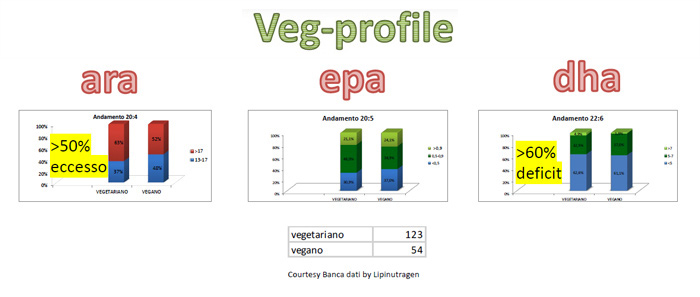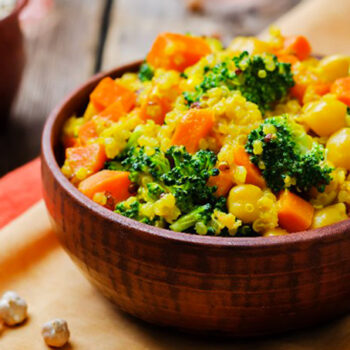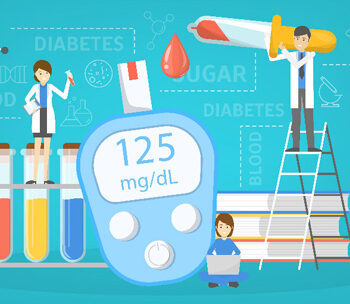
VEG DIET and MEMBRANE LIPIDOMICS

Pay attention to the intake of essential polyunsaturated fats
According to the EURISPES 2022 report, in Italy vegetarians account for 5.4% of the population while vegans are around 1.3%. Among young people, the vegan choice is more widespread (4.8% of those between 18 and 24 years old), while at the opposite pole are those over 64 (0.2%). The greatest compliance to vegetarian alimentation can be found in the age group of 25-34 years (6.4%).
The motivations driving toward vegetarianism are health, ethical, environmental, or the combination of these. A vegetarian diet has numerous positive health effects, such as lower incidence of cardiovascular disease, obesity, hypertension, diabetes, and some types of cancer.
However, given the prevalence of VEG (vegetarian and vegan) regimens in younger age groups, it is important that the diet setting is correct so that the health benefit can be real in the short term, but also in terms of prevention of chronic diseases whose onset is greater in subsequently age groups.
Fat consumption in VEG diets
One obvious difference between vegetarians and omnivores concerns the type and amount of fat in the diet. Vegetarian diets generally have a slightly lower total fat content than omnivore diets (28-32% for vegans, 30-34% for vegetarians, and 34-36% for omnivores) [2], of which the percentage of saturated fat is significantly lower, especially in vegan diets whose intake from dairy products and eggs is zero. The intake of trans fatty acids is highly dependent on the amount of processed foods routinely consumed in the diet (margarines, ultra-processed seed oil products, and soybean derivatives).
Regarding omega-3 and omega-6 PUFA polyunsaturated fatty acids, and the resulting intake of EFA essential fatty acids (alpha-linolenic acid ALA, linoleic acid LA), generally in vegetarian/vegan diets:
– omega-6 consumption is much higher than omega-3 consumption given the natural scarcity of alpha-linolenic acid sources compared with those of linoleic acid, the latter being abundant in seed oils commonly used in cooking.
– consumption of EPA and DHA (long-chain PUFAs) is low in vegetarians (since it depends only on egg consumption) and absent in vegans.
The result is a high imbalance in the omega-6/omega-3 ratio (about 15:1-20:1), comparable to that in the Western diets of some European countries, such as the Netherlands, Germany and Italy, where fish consumption is low [3]. In conclusion, in terms of PUFA balance and essential fat intake, vegetarianism offers no nutritional advantages over the omnivorous diet.
Conversion of essential fatty acids ALA and LA
Linoleic acid (omega-6 parent) and alpha-linolenic acid (omega-3 parent) are defined as essential because the body is unable to synthesize them. However, humans are able to convert LA and ALA into more physiologically active fatty acids through a series of elongation and desaturation reactions. LA is converted to DGLA and arachidonic acid, whereas ALA to EPA and DHA. The resulting highly unsaturated fatty acids are required for cell membrane function, for brain and nervous system development and function, and for the production of eicosanoids (thromboxanes, leukotrienes, prostaglandins, and prostacyclins) that are essential for the proper unfolding of inflammatory processes.
While the conversion of LA to AA is typically very efficient, the conversion of ALA to EPA and DHA is much less so: only 5-10% of ALA is converted to EPA and, of this, only 2-5% to DHA. Long-chain fatty acids of the omega-6 and omega-3 families are generally not considered essential because the body possesses the enzyme systems to synthesize them from the fatty acid parent. However, given the competition of the omega-6 and omega-3 pathways for the same converting enzymes and the low biosynthesis rates of EPA and DHA, they are considered semi-essential and are recommended to be consumed through the consumption of foods that are rich in this elements.
What are the consequences of a deficiency of essential fatty acids?
Long-chain PUFA fatty acids are precursors of molecules necessary for the proper balance of the inflammatory process. An imbalance in the production of these molecules, which have different and opposite functions (proinflammatory, anti-inflammatory, or resolving), is associated with an elevated risk of the onset of numerous disease states, including heart disease, cancer, diabetes, immune/inflammatory and neurodegenerative disorders.
Docosahexaenoic acid DHA is also an important structural component of cell membranes in the gray matter of the brain, retina, and hearth muscle cells. As a result, low levels of DHA have been associated with various neurological and behavioral disorders, such as depression, schizophrenia, Alzheimer’s disease and ADHD, reduced visual acuity and impaired brain development in children.
Lipidomic analysis in vegetarians and vegans
An analysis of 177 lipidomic profiles of vegetarians (N=123) and vegans (N=54) in the Lipinutragen database shows that the most commonly encountered imbalances are:
– excess arachidonic acid in 63% of vegetarians and 52% of vegans
– a deficiency of DHA in more than 60% of vegetarians and vegans

This finding is in line with the nutritional intakes of the two dietary regimens (deficiency of DHA sources, heavy excess of omega-6) and with our body’s fatty acid metabolism, which is influenced both by the efficiency of enzymatic conversions, but also by the excess or deficiency of certain nutrients that influence them (such as carbohydrate consumption, which, through insulin, promotes arachidonic acid biosynthesis).
How adequate PUFA levels can be ensured in vegetarians and vegans?
There are 2 approaches to improve essential fatty acid intake in VEG regimens:
- Maximize the conversion of ALA to EPA and DHA.
- Provide a direct source of EPA and DHA.
In the impossibility of balancing the consumption of sources of EPA and DHA (found in fish and meat) with the more ubiquitous omega-6, LA and arachidonic acid, it is first necessary to monitor the balance of PUFAs in cell membranes and then make appropriate nutritional choices based on the actual needs of the person.
To strengthen the omega-3 conversion pathway in vegetarians/vegans, who do not consume direct sources of EPA and DHA, it is possible to double the intake of ALA from plant sources such as flaxseeds and walnuts. At the same time, it is possible to improve (i.e. decrease) the omega-6/omega-3 ratio so that, overall, at the enzymatic level, the conversion of ALA to EPA and DHA is favoured. This can be achieved by aiming for an omega-6/omega-3 ratio between 2:1 and 4:1. For this reason, increased consumption of ALA will have to be accompanied by decreased consumption of LA, especially by avoiding omega-6-rich cooking oils such as sunflower oil (53% LA), corn oil (52% LA), peanut oil (28% LA) grapeseed oil 8%LA) and soybean oil (54% LA). Processed foods, ready-to-eat meals and vegetarian snacks, now common on supermarket shelves, should also be moderated as they are prepared with soy and the aforementioned vegetable oils. In contrast, whole foods fortified with sunflower seeds, pumpkin seeds, sesame seeds, and natural dried fruits (except peanuts and pistachios) should not be avoided but consumed in a balanced way, as they also provide monounsaturated fatty acids (oleic acid) and a variety of other beneficial dietary components, including fiber, B vitamins, vitamin E, and trace minerals.
Finally, for those who have an increased need for EPA and DHA (e.g., pregnant or lactating women, people with neurological diseases) or who may have altered enzymatic conversion in PUFA fatty acid pathways (e.g., diabetics and the elderly), it would be appropriate to opt for the introduction of direct sources of EPA and DHA on a precautionary basis or following membrane lipidomic analysis to establish a customized supplementation plan and to monitor trends in essential fatty acid levels over time.
Article by the Editorial Group of Lipinutragen
The food recommendations in the article are not intended as a substitute for a personalized meal plan and are to be adapted to specific cases.
Bibliography
[1] https://eurispes.eu/news/sintesi-dei-risultati-del-rapporto-italia-2022/
[2] Messina MJ, Messina VL. The dietitian’s guide to vegetarian diets: issues and applications. Gaithersburg, MD: Aspen Publishers, 1996.
[3] Welch AAet al. Variability of fish consumption within the 10 European countries participating in the European Investigation into Cancer and Nutrition (EPIC) study. Public Health Nutr. 2002 Dec;5(6B):1273-85.
For further reading:
BOOK: “Dalla parte dei grassi. Lipidomica in cucina; perché i grassi non sono tutti uguali e dobbiamo conoscerli” by Dr. Carla Ferreri, CNR First Researcher and Scientific Director of Lipinutragen
Photo: 123RF Archivio Fotografico: 52585656 : ©marilyna
- On 21 October 2022



